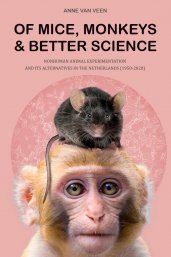"Animal testing still revolves around human health"
Treatment of laboratory animals changed, but humans remained in charge
The treatment of laboratory animals has improved over the past seventy years, but our attitude towards them has not changed significantly. That is the conclusion of PhD student Anne van Veen, who mapped developments in the use of test animals in the Netherlands, between 1950 and 2020. For alternatives to animal testing to really take off, people need to change their relationship with animals fundamentally, says to Van Veen.

The situation of laboratory animals seems to have improved considerably in recent decades. They live in more spacious surroundings and receive better treatment, while scientists do their best to develop alternatives to animal testing. But if you look at it more fundamentally, very little has actually changed, says PhD student Anne van Veen.
According to Van Veen, people still have the same attitude towards animal testing: it essentially revolves around the interests of humans, while laboratory animals come in second place. People also believe that it is still up to humans to decide on the fate of laboratory animals, according to the researcher.
Archives on animal testing
For this study, Van Veen collaborated with the Dutch National Institute for Public Health and the Environment (RIVM). There she examined archives on animal testing, analysing which tests took place within the institute and elsewhere, how they were carried out and how scientists work on alternatives to animal testing. Van Veen paid special attention to the experiences of specific groups of laboratory animals, including monkeys used in polio research. Van Veen presents the results of the research in her thesis Of Mice, Monkeys & Better Science, which she defends today at Utrecht University.
Little criticism and rules
In the 1950s and 1960s the number of animal experimentation increased rapidly. This was partly due to the growing development of new medicines that had to be tested. There was also more attention for the potential harmfulness of medicines and other substances. Also, industry produced many new substances, the effects of which were still unknown. Legislation on animal testing did not yet exist, and social criticism was rare, partly because many medical breakthroughs at the time had led to a very positive image of science.
Rabbits brought home
Rules about hygiene and safety in laboratory animal research were also less strict in those days. This led to practices that would be considered surprising today. In the 1960s, for example, it was common for laboratory staff to take test rabbits home for consumption. Van Veen discovered the staff even had an allocation key whereby colleagues with the lowest income received the most.
Dealing with laboratory animals
The treatment of laboratory animals has changed significantly in recent decades. Van Veen: "Everyone who deals with test animals now is aware that the animals can suffer and experience pain. In the 1950s, many researchers still claimed that so-called pain signals were nothing more than a kind of automatism. A loud squeak during an apparently painful procedure did not necessarily mean that the animal was actually in pain. That has really changed."
Improvements have never gone against the human interest, because that is still our main concern in in animal testing
Over the years, the accommodation also improved. Test animals are now housed in more spacious accommodation and are given materials to enrich their surroundings. The welfare of test animals has generally improved, Van Veen says, but ultimately it is still humans who determine what happens. "The improvements have never gone against the human interest, because that still comes first. Animals are not allowed to have a say in it."
Inclusion in animal testing
Van Veen was surprised that animals are still not allowed to have a voice in the debate on the future of animal testing, while many people worldwide call for a more inclusive society. "Lots of studies have shown that the dividing line between humans and other animals is not that hard at all. Within the use of laboratory animals, however, this dividing line has always been maintained. Yet other animals can also have forms of language or communication. For people, it will really be a search for ways to involve animals in the future of research on animals."
By focusing on welfare and alternatives, the more fundamental discussions about ethics and relations between humans and animals are avoided.
Van Veen argues that scientists are right to look for alternatives to animal testing, and have varying success in doing so. But the focus on human welfare stands in the way of major breakthroughs, she says. According to Van Veen, alternatives to animal testing are only embraced if they advance science and don’t impede human health in any way. "That starting point is understandable in itself. But it also implies that it is okay to use laboratory animals as long as these alternatives are not harmful to human health."
Striking paradox
According to Van Veen, better treatment of laboratory animals leads to a striking paradox. In a certain sense, improved welfare can actually legitimize animal testing, according to the researcher. "People may start to think that it is okay to use test animals because the animals are well cared for. By focusing on welfare and alternatives, the more fundamental discussions about ethics and power relations between humans and animals are avoided."
PhD defence
Anne van Veen defends her thesis Of Mice, Monkeys & Better Science on 20 September 2021.
For more information please visit: https://www.uu.nl/en/events/phd-defence-of-mice-monkeys-and-better-science

